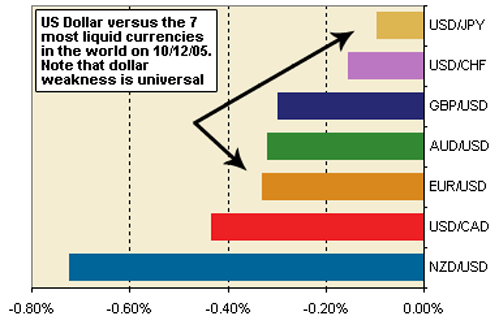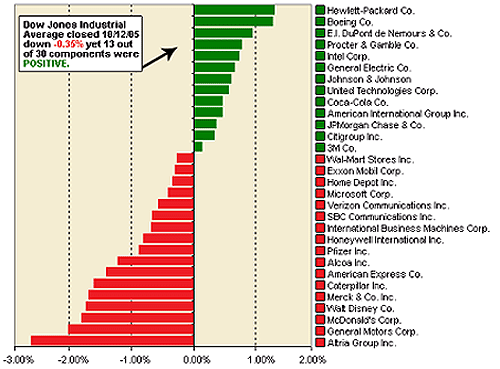 |
| Figure 2: In FX, most traders (those trading the seven most liquid currency pairs) are presented with only one choice - dollar bull or dollar bear - but the stock market is less straightforward. As this chart shows, even when an index like the DJIA is down overall, many of its stocks can be up, making it harder to take a purely bearish or bullish outlook. |
| Source: DowJones.com |
Both of these charts clearly illustrate that while the stock market is truly a market of stocks, the currency market is really a market of dollars and anti-dollars. The central reason why this is so is that the dollar serves as the
reserve currency for the world's
central banks. Therefore, when speculators are bullish on the dollar, capital will flow from all the major currencies into the greenback and vice versa when the sentiment reverses.
Crosses Offer More Possibilities
If you look closely at Figure 1, however, you'll notice that the capital flows are far from uniform. Some currencies appreciate substantially against the dollar, while others gain barely a few basis points. This difference in performance against the greenback creates profit opportunities for market players who choose to trade in currency crosses. Crosses are simply a measure of the relative strength of an individual currency against the dollar. Crosses are distinguished by the fact that they do not include the dollar as either the numerator or the denominator of the pair. As such, they offer traders a tremendous opportunity to make far more nuanced bets in the currency market than the simple pro- or anti-dollar trade.
What makes crosses especially interesting to currency traders is the fact that they can provide much cleaner trend or
range signals which will be unaffected by the day-to-day oscillations of the greenback.
To better understand how crosses work, let's examine the following two charts, which look at data over the same period of time (from July 1, 2005 to October 14, 2005). While the most liquid financial instrument in the world - the EUR/USD - has done nothing but range aimlessly during the period in question, frustrating both bulls and bears (see Fig. 3), the CAD/JPY has displayed one of the purest trends in recent memory, gaining almost 1,000 points without any material
retracement (see Fig. 4).
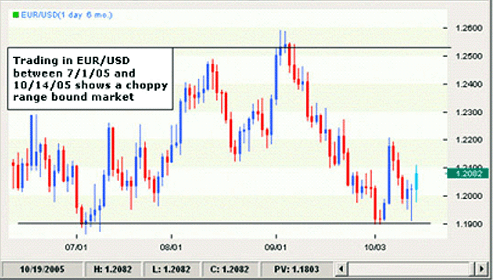 |
| Figure 3: The EUR/USD has traveled between support and resistance, making it very frustrating for bulls and bears alike. |
| Source: FXTrek |
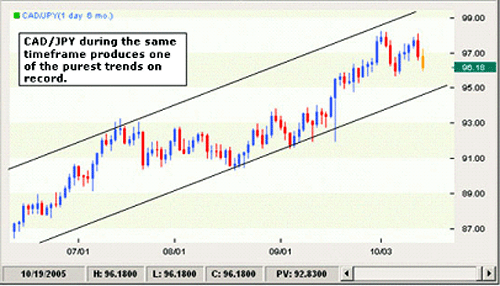 |
| Figure 4: Traders of currency crosses were able to profit from the prolonged uptrend of the CAD/JPY. |
| Source: FXTrek |
Why did the CAD/JPY rally? As we mentioned earlier, the Canadian dollar is a petrocurrency that has received a tremendous boost from the stratospheric rise in the price of crude. The yen, on the other hand, is the principal victim of high oil prices because it is the only highly industrialized country in the world that must rely on imports for 99.5% of its petroleum needs. The CAD/JPY, therefore has an 89%
correlation with the price of oil.
Canny traders who bet on an oil rally could have expressed that opinion very effectively in the currency market through a long CAD/JPY position. Even better, they would have harnessed a positive yield differential in the process. With the loonie currently yielding 2.75%, while the yen rates remain at 0%, the interest rate differential alone was 275
basis points or 27.5% annualized using a standard 10:1 leverage factor.
(This essentially means that since FX traders can use $1 of capital to control $10 worth of currency, the gain from the 275 basis point differential will be 10 times larger than if traders did not use leverage.)
Carry or Capital Gains
Crosses can be as volatile as the most heavily-traded stocks during the heyday of the Nasdaq bubble or as sedate as a 'AAA'-rated dividend-yielding utility share on the NYSE. Trading in crosses can focus on carry strategies that try to profit from interest rate differentials between the currencies or it can be focused on pure capital gains speculation. Trades can also be based on economic analysis or political news. Some crosses can trend for months, while others will be highly
range-bound. In short, the possibilities with currency crosses are endless. Let's look at the charts below to see some examples of recent trades in the crosses that demonstrate these ideas.
The Carry Trade
One of the most popular trades in foreign exchange is the
carry trade,
which involves going long a high-yielding currency against a low-yielding one. Looking at the seven most liquid crosses in the world, no pair has shown a greater interest rate differential than the NZD/JPY pair. In mid-October 2005, the New Zealand dollar, nicknamed the "kiwi", yielded 6.75% (the Reserve Bank of New Zealand subsequently increased that rate to 7% at the end of October). The Japanese yen., on the other hand, yielded 0% (as of October 2005), and the Bank of Japan's zero interest rate monetary policy is expected to remain in effect until all vestiges of deflation are gone from the Japanese economy. The spread between the currencies was a whopping 675 basis points, and as a result, carry trade speculators plowed into the cross, increasing its value by 400 pips between July and October 2005.
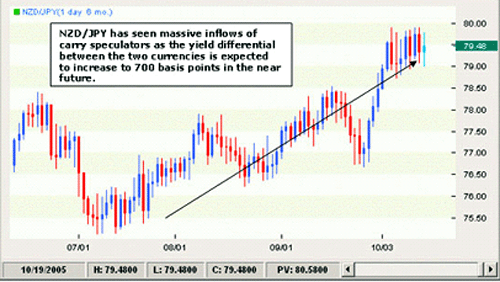 |
| Figure 5: The NZD/JPY pair gained momentum in the three months shown here in response to widespread speculation that the NZD rate would increase to 7% in Nov 2005. Carry trade speculators plowed into the cross in order to gain exposure to this higher rate differential, causing the NZD/JPY to increase in value |
| Source: FXTrek |
The Political Trade
In mid-September 2005, both Japan and Germany had elections. In Japan, Prime Minister Junichiro Koizumi ran on a reform agenda that called for the privatization of the Japanese postal service, a quasi-banking institution with $3 trillion in deposits and 25,000 branches. InGermany, the reform-minded candidate Angela Merkel ran against the standing Chancellor Gerhard Schroeder. While Koizumi's message resonated well with the Japanese voters as he headed to an overwhelming win, Merkel's victory over Schroeder was hard-fought - the two contenders were locked in a struggle for leadership for more than a month after the German elections were initially held. In September 2005, therefore, the EUR/JPY cross presented a tremendous profit opportunity as a de facto "Koizumi/Schroeder spread". Indeed, from September 9 to September 12, the cross tumbled nearly 200 points as traders bid up the yen and shorted the euro as a response to the election results.
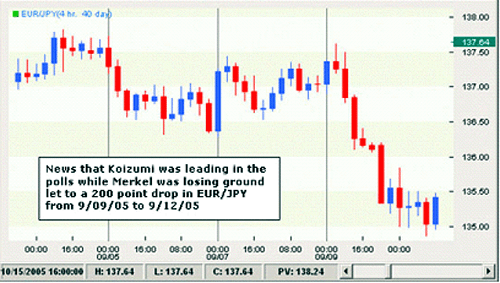 |
| Figure 6: The chart above shows the weakness in the euro which could be attributed in part to the uncertainty over the outcome of the German elections. FX traders were more inclined to place their money in the Japanese yen, because the political situation in Japan was more certain |
| Source: FXTrek |
The Economic Trade
Consistent disparities in economic performance can sometimes offer very profitable trades in the crosses. A case in point is the price action in the second half of 2005 in the EUR/CHF currency cross. The massive declines in the two currencies during the first half of 2005 were beneficial for both the euro zone and Switzerland since both regions are heavy exporters and both generate substantial trade surpluses. However, the smaller and more nimbleSwitzerland did not suffer from the political and institutional disarray that pervaded the euro zone after the rejection of the EU Constitution in the summer of 2005. With much better unemployment numbers (3.8% in Switzerland vs. 9.9% in EU) and faster growing retail sales (4.7% vs. 0.9%), Switzerland was clearly outperforming its much larger neighbor next door. As the realization of this fact began to permeate the market, the EUR/CHF cross (one of the least volatile crosses in the market) declined by over 100 points in the period between late September and early October 2005 shown in Figure 7.
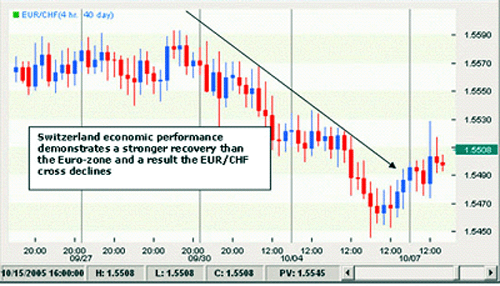 |
| Figure 7: The cross shown here illustrates Switzerland's resilience to the economic and political hardships that were happening in the euro zone |
| Source: FXTrek |
The Volatility Trade
If you are a trader who likes volatility and lots of it, nothing provides more action than the GBP/JPY cross. Trading this cross is akin to trading a volatile technology stock; it often moves several hundred points in a day. One of the key reasons for such wild price action is that GBP/JPY is also a very popular carry trade. With U.K. rates at 4.50% in October 2005 and Japan's rates at 0%, the interest rate differential was 450 basis points.
A slowdown in the U.K. economy caused the Bank of England to lower rates by 25 basis points in September 2005, and with the market highly uncertain of whether this was a one-off move or a hint of more rate cuts to come, trading in the GBP/JPY looked set to be especially turbulent, thus providing volatility-seeking traders with plenty of opportunities.
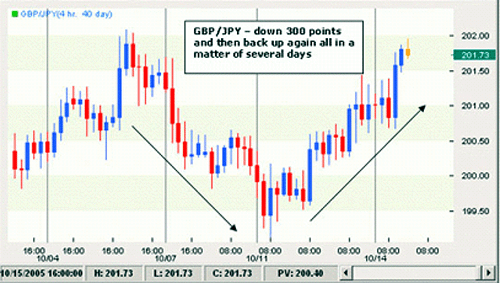 |
| Figure 8: There are currency crosses to suit all types of traders. This chart shows the GBP/JPY, which is one of the most volatile crosses. |
| Source: FXTrek |
Conclusion
The examples discussed here should give you a sense of the variety of trades that are possible using cross currencies in the FX market. Typically, 90% of all trading by volume in forex takes place across the four major currency pairs. However, for traders willing to step out of the crowd and explore a different path, trading in currency crosses can provide a multitude of profitable opportunities and should become a standard part of any FX trader's arsenal of ideas.












